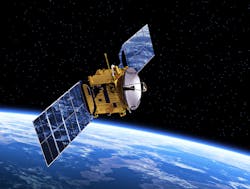NASA making big push for sophisticated electro-optical sensors for Earth-observation satellites
THE MIL & AERO COMMENTARY – U.S. Earth-observation specialists are placing renewed emphasis on space-based sensors development for ever-more-sophisticated electro-optical satellite payloads to keep tabs on how the planet's environment is evolving.
These satellite sensor payloads will involve electro-optical sensors, RF and microwave sensors, or a combination of both -- including hyperspectral sensors, which involve slicing images into many different spectral bands to uncover details that otherwise might be hidden.
Just this week, the National Aeronautics and Space Administration (NASA) announced plans to ask industry to develop a new hyperspectral infrared sensor to fly on the Geostationary Extended Observations (GeoXO) series of geostationary Earth-observation satellites.
The sensor will be a hyperspectral ultraviolet-through-visible-imaging spectrometer to measure environmental data as part of a 3-axis stabilized geostationary weather satellite system. It will imagery for national air quality forecasting, hazard forecasting, and fire pollutant forecasting and warnings.
NASA officials say they expect to ask industry to build two ACX sensors flight models, with an option for an additional spare flight model. The base contract will ask industry to build, deliver, integrate, and support one flight model and parts for a second flight model. A draft RFP is expected in July, and a final RFP is expected in September. The anticipated contract award date is April 2024.
A separate sensor payload for the GeoXO satellites is called the GeoXO Lightning Mapper (LMX) instrument, which will be a single-channel near-infrared optical persistent surveillance sensor to monitor for potentially damaging lightning storms near the Earth's surface, which could indicate threats to property, commercial aviation, and the formation of tornadoes.
NASA announced plans in late April to release a formal solicitation for the LMX instrument sometime this month. Lightning mapping from geostationary orbit improves severe storm analysis and increases lead time to detect tornado formation. The LMX instrument should improve lightning hazard detection, hurricane intensity prediction, wildfire detection and response, heavy rain estimation, and aviation hazard mitigation.
Geostationary lightning data is available where other sources are more limited -- especially over oceans and in mountainous and rural areas. The data updates faster than local radar, and also fills-in radar coverage gaps. Lightning is an essential climate variable necessary to understand and predict changes in climate, NOAA experts say.
The LMX instrument will collect data visible from geostationary orbit for severe atmospheric temperature and water vapor profiles for weather forecasting and atmospheric monitoring, as well as measure the location and intensity of optical transients from lightning to help forecast severe weather and to issue warnings for public safety.
In April 2022 NASA awarded $5 million study contracts to the Northrop Grumman Corp. Space Systems segment in Azuza, Calif., and to the Lockheed Martin Corp. Space Systems segment in Littleton, Colo., to define the LMX instrument.
Also this month, NASA announced plans to ask industry to study sensor payload alternatives for a future atmosphere-observing satellite that operates in a polar orbit around the Earth, as NASA issued a presolicitation for the Atmosphere Observing System-Polar (AOS-P) Polarimeter Instrument Phase A Study.
This study will suggest potential sensors concepts to support future AOS-P missions, and how these concepts meet performance targets, maturity, and acceptable risks. An AOS-P request for proposals is expected around 1 June, with proposals due by 30 June 2023.
The study will assess instrument concepts; explore the feasibility of future sensor enhancements; possible development schedules and costs; and identify hardware, software, and risk mitigation.
Polar orbits place sensors and electronics in hazardous environments because of high radiation levels, which require radiation-hardened electronic components, as well as other safeguards to protect orbiting electronics from the harsh environment of polar orbit. The study will tell NASA about the feasibility and risks of current Polarimeter requirements and design concepts, and help improve requirements for a potential Polarimeter Instrument solicitation.
Not only will these projects involve sophisticated sensors development, but also will call for environmental hardening against the effects of space radiation, shock and vibration from satellite launches, and the temperature extremes of orbital space.
About the Author
John Keller
Editor-in-Chief
John Keller is the Editor-in-Chief, Military & Aerospace Electronics Magazine--provides extensive coverage and analysis of enabling electronics and optoelectronic technologies in military, space and commercial aviation applications. John has been a member of the Military & Aerospace Electronics staff since 1989 and chief editor since 1995.
